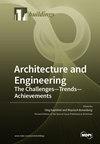Simple Nonlinear Numerical Modeling for Unreinforced and FRP-Reinforced Masonry Domes
IF 3.1
3区 工程技术
Q2 CONSTRUCTION & BUILDING TECHNOLOGY
引用次数: 0
Abstract
This paper presents a new method to model the nonlinear behavior of double-curvature masonry structures, possibly reinforced by composite materials, by means of conventional elasto-plastic analyses. The method is meant to be used in professional design, especially for assessment and retrofitting purposes, based on the exploitation of the simplest nonlinear finite elements available in commercial software, namely, trusses with elasto-fragile and elasto-ductile behavior (Cutoff Bars, according for instance to the definition provided by Strand7 R3.1.3a). Numerical static nonlinear analyses are carried out by considering elastic hexahedral elements for bricks and by lumping nonlinearities on joints. These are assumed, in turn, to be elastic–brittle and elastic–plastic by using 1D elements, namely, Point Contacts, under the No-Tension Material hypothesis, and Cutoff Bars, respectively, assigning a small tensile resistance to the material. The reinforcement, realized with FRP hooping strips, is successfully modeled in a similar fashion, i.e., by applying perfectly bonded elastic–plastic Cutoff Bars at the extrados of the dome, where debonding is accounted for in a conventional way, limiting the tensile strength according to Italian Standards’ indications. The procedure is validated against benchmark models with the same geometry, using experimental data and more refined structural model results for comparison. After an in-depth analysis of the obtained results, in terms of capacity curves, the robustness and accuracy of the proposed approach are assessed.非加固和 FRP 加固砌体穹顶的简单非线性数值建模
本文提出了一种新方法,通过传统弹塑性分析,对可能由复合材料加固的双曲率砌体结构的非线性行为进行建模。该方法旨在用于专业设计,特别是用于评估和改造目的,其基础是利用商业软件中最简单的非线性有限元,即具有弹塑性和弹塑性行为的桁架(Cutoff Bars,例如根据 Strand7 R3.1.3a 提供的定义)。在进行静态非线性数值分析时,考虑了砖块的弹性六面体元素和接缝处的叠加非线性。反过来,通过使用一维元素,即无张力材料假设下的点接触和截断杆,分别假设它们为弹性脆性材料和弹性塑性材料,并为材料分配一个小的拉伸阻力。用玻璃钢箍条实现的加固也以类似方式成功建模,即在穹顶外侧应用完全粘合的弹塑性截断条,按照传统方式考虑脱粘,并根据意大利标准限制抗拉强度。通过实验数据和更精细的结构模型结果对比,该程序与具有相同几何形状的基准模型进行了验证。在对所获得的结果进行深入分析后,从承载力曲线的角度,对所建议方法的稳健性和准确性进行了评估。
本文章由计算机程序翻译,如有差异,请以英文原文为准。
求助全文
约1分钟内获得全文
求助全文
来源期刊

Buildings
Multiple-
CiteScore
3.40
自引率
26.30%
发文量
1883
审稿时长
11 weeks
期刊介绍:
BUILDINGS content is primarily staff-written and submitted information is evaluated by the editors for its value to the audience. Such information may be used in articles with appropriate attribution to the source. The editorial staff considers information on the following topics: -Issues directed at building owners and facility managers in North America -Issues relevant to existing buildings, including retrofits, maintenance and modernization -Solution-based content, such as tips and tricks -New construction but only with an eye to issues involving maintenance and operation We generally do not review the following topics because these are not relevant to our readers: -Information on the residential market with the exception of multifamily buildings -International news unrelated to the North American market -Real estate market updates or construction updates
 求助内容:
求助内容: 应助结果提醒方式:
应助结果提醒方式:


